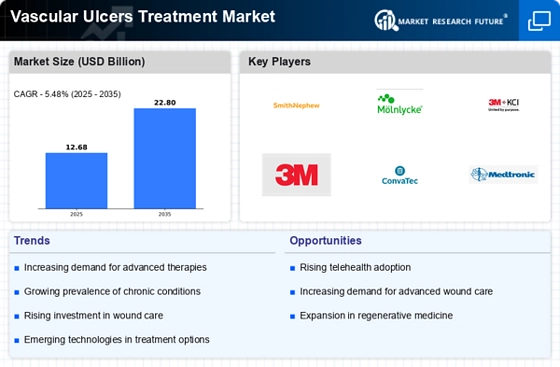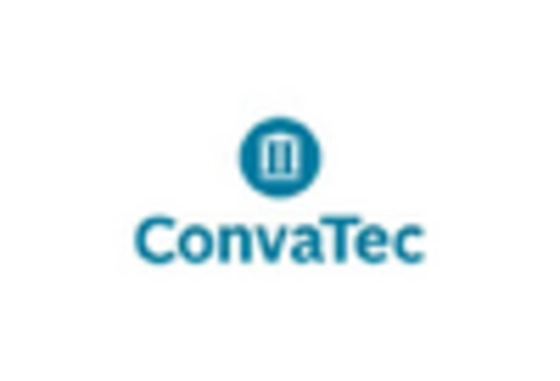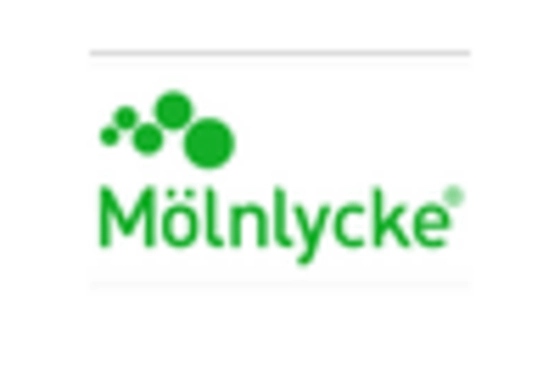Growing Awareness and Education
Increased awareness and education regarding vascular ulcers are pivotal drivers of the Vascular Ulcers Treatment Market. Healthcare professionals and patients alike are becoming more informed about the risks and management of vascular ulcers. Educational initiatives aimed at both medical practitioners and the general public are fostering a better understanding of prevention and treatment strategies. This heightened awareness is likely to lead to earlier diagnosis and intervention, which can significantly improve patient outcomes. As a result, the demand for effective treatment options is expected to rise, propelling the Vascular Ulcers Treatment Market to new heights. The emphasis on education is thus a critical factor in shaping market dynamics.
Government Initiatives and Funding
Government initiatives and funding play a crucial role in shaping the Vascular Ulcers Treatment Market. Various health authorities are increasingly recognizing the burden of vascular ulcers on healthcare systems and are implementing programs aimed at improving treatment access and quality. Funding for research and development of new treatment modalities is also on the rise, with governments allocating resources to combat chronic wounds. These initiatives not only enhance the availability of advanced treatment options but also promote public health campaigns that raise awareness about vascular ulcers. Consequently, the Vascular Ulcers Treatment Market is likely to benefit from these supportive measures, leading to improved patient care and outcomes.
Rising Incidence of Chronic Diseases
The Vascular Ulcers Treatment Market is significantly influenced by the rising incidence of chronic diseases, particularly diabetes and cardiovascular conditions. These diseases are known to contribute to the development of vascular ulcers, leading to an increased demand for effective treatment options. According to recent data, approximately 30% of individuals with diabetes may develop foot ulcers, which can escalate into more severe vascular complications. This alarming statistic underscores the urgent need for comprehensive treatment solutions. As healthcare systems adapt to manage these chronic conditions, the Vascular Ulcers Treatment Market is likely to expand, driven by the necessity for specialized care and innovative treatment approaches.
Technological Innovations in Wound Care
The Vascular Ulcers Treatment Market is experiencing a surge in technological innovations that enhance treatment efficacy. Advanced wound care technologies, such as bioengineered skin substitutes and negative pressure wound therapy, are gaining traction. These innovations not only improve healing rates but also reduce the overall treatment duration. For instance, the introduction of smart dressings that monitor wound conditions in real-time is revolutionizing patient management. The market for advanced wound care products is projected to grow significantly, with estimates suggesting a compound annual growth rate of over 6% in the coming years. This trend indicates a shift towards more effective and efficient treatment modalities, thereby driving the Vascular Ulcers Treatment Market forward.
Aging Population and Increased Healthcare Demand
The aging population is a significant driver of the Vascular Ulcers Treatment Market. As the demographic landscape shifts, the prevalence of age-related conditions that contribute to vascular ulcers is expected to rise. Older adults are more susceptible to chronic diseases, which in turn increases the likelihood of developing vascular ulcers. This demographic trend is prompting healthcare systems to adapt and expand their services to meet the growing demand for specialized treatment. Projections indicate that the number of individuals aged 65 and older will double by 2050, further intensifying the need for effective vascular ulcer management. Thus, the aging population is a key factor influencing the trajectory of the Vascular Ulcers Treatment Market.


















Leave a Comment